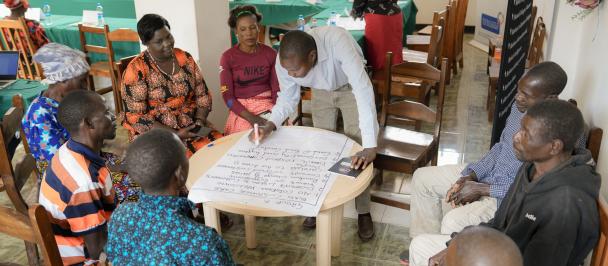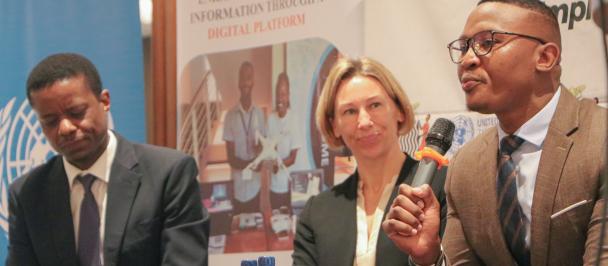Making artisanal mining more efficient for small scale mining
The women and youth dominated space of artisanal small-scale mining (ASM) presents many opportunities for innovation, development and stimulation of the local fabrication and manufacturing industry. The cooperatives and miners within the space work tirelessly to convert development minerals like quartz, silica, river sand, and granulite into valuable goods ready for industrial and commercial use.
ASM is a broad field, encompassing the creation of value from a range of raw materials to produce goods such as bricks and paving stones for construction, quarry dust and silica for use in the mining industry, granite and gemstones for counter tops, jewellery, and decorative items for retail.
UNDP has been working collaboratively with the Government of the Republic of Zambia, through the Ministry of Mines and Minerals Development to provide opportunities for Artisanal and Small-Scale Mining projects through the Africa, Caribbean, and Pacific (ACP) Secretariat, with finances from the European Union (EU). Through the Accelerator lab, the ACP-EU Development Minerals project intends to expand the scope of this support to include supporting local innovators to participate in the Development Minerals value chain, leveraging government deliberate focus on Micro, Small and Medium Enterprises. The Accelerator Lab and Minerals Development project embarked on a solutions safari through Zambia’s Southern, Copperbelt, and Eastern provinces, where the team met with cooperatives and artisanal miners as well as innovators to discuss their processes, gauge their concerns and to extract suggestions and innovative ideas for growth within the sector. These conversations revealed a need for ASM geared innovations within the machinery fabrication and digital platform development spaces.
Many of the cooperatives and miners shared that the tools that are readily available for their sector are either not portable enough for them to make effective use of them on site, too expensive or incredibly manual. For example, rock quarry miners break boulders, crush rocks, sieve materials and transport the final product to the sales floor using a combination of picks, hammers, shovels, and improvised sieves, and sacks/buckets that exposed the users to health risks. Further, individual miners need to produce between 1 and 2 tons of product to receive a reasonable payment for their goods. With the current tools, this process takes anywhere between 2 to 3 months. Often, miners within cooperatives either have to procure piece work from or offer piece work to other miners to quicken the process or supplement their earnings.
Many of the cooperatives and miners shared that the tools that are readily available for their sector are either not portable enough for them to make effective use of them on site, too expensive or incredibly manual. For example, rock quarry miners break boulders, crush rocks, sieve materials and transport the final product to the sales floor using a combination of picks, hammers, shovels, and improvised sieves, and sacks/buckets that exposed the users to health risks. Further, individual miners need to produce between 1 and 2 tons of product to receive a reasonable payment for their goods. With the current tools, this process takes anywhere between 2 to 3 months. Often, miners within cooperatives either have to procure piece work from or offer piece work to other miners to quicken the process or supplement their earnings.
The miners shared that tools such as portable crushing machines, fortified hammers, movable and portable conveyor belts systems, and loading aids, could improve their productivity. Lucy Nakawala, the Chairperson of Zimba Mines Cooperative in Mufulira, noted in Bemba that “Excavators, crushers, wheelbarrows, and other tools will make our work very easy. Currently, we have to carry the stones and products with buckets on our heads”.
With these tools, the miners explained that they would have capacity to boost their own productivity, scale up their operations, and improve the regularity of their earnings. The cooperatives demonstrated a preparedness to purchase these items and other relevant innovations by pooling their collective resources together, should they have access to the right suppliers.
Moreover, there was a general trend across the development mining space that indicated limited market access as an additional challenge. As the local market is currently not fully aware of the wide range of development minerals available for purchase locally, potential customers skew towards imported goods under the perception that these products do not exist in Zambia or that the quality does not compare to imported goods. This positions the miners, and their cooperatives to rely on middlemen and become/remain susceptible to price setting by customers. This tends to undervalue the cost of production and leave the miners’ earning less than they would with broader market access.
The miners explained that by reaching out to local markets and presenting their goods for display at fairs and in stalls, local consumers would be made aware of their goods, their value, and availability. “We don’t have a challenge sourcing material, our biggest challenge is finding where to sell the stones. If you look around the industry, you find that most [sellers] say they have got a lot of stones ready for market but unfortunately, we have limited people that can buy stones in bulk… We would like to step out on the weekends to go and market our products in town and in public spaces” says Joseph Mbewe, a gemstone cutter from Ndola. Mbewe adds that he is interested in using digital platforms and that he has the tools to support digital marketing, but he has concerns about security online, saying, “We have computers and I have a phone that uses the internet, the only thing is learning how to go about it so that we don’t meet with fraudsters on [social media] and we don’t lose out in terms of security.”
In conversation with the Gemstone Processing and Lapidary Training Centre (GPLTC), it also become clear that digital marketing solutions could evolve in the ASM sector now and in the future, potentially promising a wide reach for the cooperatives to markets across the country and beyond without the dependence of a middle person.
After engaging with the miners, the team explored the fabrication and innovation space by meeting with key strategic partners like the Northern Technical College (NORTEC), GPLTC, and Chipata Trades Training Institute. These institutions confirmed the team’s hypothesis that there were facilities and opportunities for fabrication and machining locally. By tapping into the wealth of resources in the form of lathe machines, sheering and cutting machines, and Computerised Numerical Control (CNC) machines amongst others, this will open a door to a world of options – a world in which innovative minds connect to the right tools that can convert their ideas into prototypes and then tangible products ready for industrial use by the ASM sector.
Local innovators like Darius Mambwe and Charles Bensaia are but two examples of the massive potential for the practical execution of innovative ideas that are directly geared at the ASM sector. From used car parts and second-hand motors sourced from the open market, to bottles and melted plastic waste, they have created simple solutions to complex problems from locally available and recycled materials.
As the mining industry is often characterised by unsustainable practices and a widespread negative environmental impact, the novel thinking of these innovators and the local ASM machinery fabrication space offers an opportunity to approach and align both machining and production towards more environmentally sustainable practices.
The next stage will consist of designing strategies to draw out these innovators and connect them with the networks of tools and resources needed to execute their ideas. Further, by connecting innovators and the systems that can actualise their concepts into tactile products within the ASM sector and the end-users, the ideas and challenges of the miners and cooperatives will be directly addressed in the development of machinery and platforms.
This also presents an opportunity to generate awareness and sensitise the local market to the wide range of valuable and locally produced goods to be found in the ASM sector – challenging local perceptions of development minerals and locally manufactured items.
As the field is dominated by women and the youth, the hope is that through catalysing innovations within the sector, the project will be accelerated towards achieving SDG 5: Gender Equality, SDG 8: Decent Work and Economic Growth, SDG 9: Industry, Innovation and Infrastructure, and SDG 10: Reduced Inequalities.

 Locations
Locations





